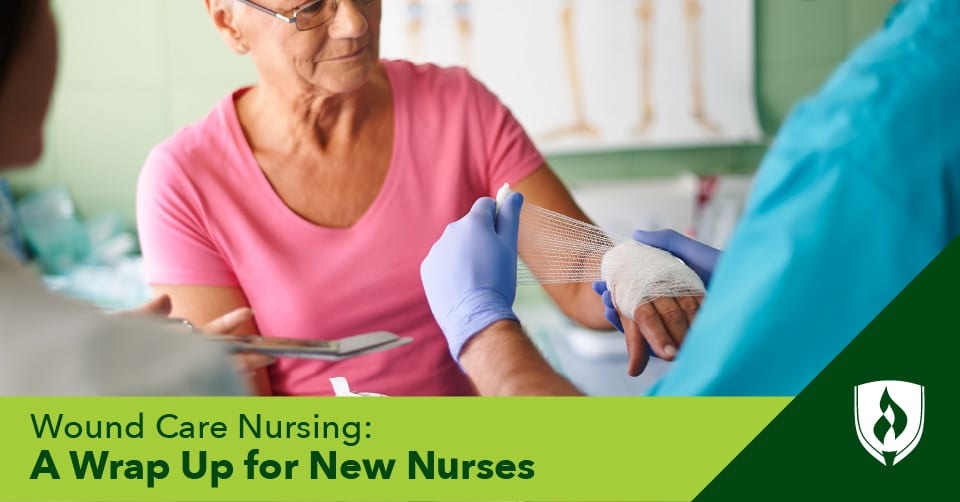If you’re not familiar with the nursing field, you might assume “wound care” is just an everyday part of the job. While it’s true many nurses are tending to minor cuts and scrapes as part of their day-to-day duties, only a small portion of nurses possess a deep, specialized skill set for treating more advanced wounds and injuries.

What many people might not realize is just how many types of wounds there are and how complex their proper treatment can be. There are penetrating wounds like a gunshot wound or an electric burn. There are pressure wounds like ulcers or bed sores, and there are blunt force trauma wounds such as skin tears. There are also closed wounds that occur within the body or underneath your skin like blisters or hematomas. You can rely on your body to heal some wounds, while others will only fester, develop an infection or worsen if left without proper treatment.
With all that and so much more to potentially contend with, you can see why wound care sometimes requires expert specialists to be done effectively. The healthcare system needs nurses with wound care expertise to help patients recover as seamlessly and comfortably as possible.
If you are curious about wound care, keep reading! We will lay out some of the most important aspects of wound care nursing you should know.
What is wound care nursing?
Wound care nursing is a subspecialty of nursing dedicated to the effective assessment and treatment of wounds.
While you might (correctly) assume these nurses tend to wounds from emergency situations, there’s also a need for this expertise when treating common chronic conditions like diabetes and the complications associated with them. Diabetes, for example, impacts over 30 million people in the U.S., and out of this population, a significant number will develop a diabetic foot ulcer (DFU) at some point.1 Without proper care, these ulcers can lead to infection and even amputation.
This also means there’s some variety in where nurses with wound care expertise work. Some spend their time working at specialized wound care clinics, others in hospital burn units, long-term care facilities or as a floating specialist nurse at hospitals.
“Wound care nurses see patients either in the hospital or in a clinical or home health setting,” says Dr. Jenna Liphart Rhoads of Nurse Together. “Wound nurses see patients regularly and provide more advanced wound care than a nurse who is not wound care certified.”
Though commonly referred to as simply “wound care” nursing, many in this role have specialized training in caring for patients with ostomies and continence issues as well.
What does a wound care nurse do?
Wound care nurses assess and treat wounds, typically wounds that take longer than two weeks to heal. They develop in-depth knowledge about skin breakdown, injury, infection and complications in both acute and chronic wounds. This specialty knowledge is especially useful for treating patients in long-term care facilities who are dealing with chronic wounds or sedentary conditions that create a high risk for pressure ulcers.
“Wound management specialists are experts in addressing the complexity of a patient’s medical diagnosis when the risk of skin injury exists and also when it occurs,” says Dr. Kathleen Thimsen, associate professor at UNLV School of Nursing. Because of this, many healthcare facilities that serve patients at risk for wounds make sure they have wound management specialists on the payroll. “Having access to a wound specialist nurse offers comprehensive evaluations coupled with comprehensive solutions.”
This arrangement can make wound care a relatively unique role, as they take on a consultative approach, guiding and educating other nurses on proper treatment and best practices when tending to wounds they may rarely encounter.
What do wound care nurses like about their work?
One thing wound management specialists and wound care nurses know is this work is intellectually challenging. With each patient you see, you need to continuously apply cell biology, chemistry and personalized communication, according to Thimsen. You need a strong understanding of tissue breakdown and patient needs related to nutrition, hydration, prevention and intervention strategies along with adherence to evidence-based therapeutic protocols and practices.
“Of course, being competent with documentation protocols is also imperative as they support compliance to regulatory and legal aspects of the wound healing industry,” Thimsen says.
Because many wound care nurses work with patients for an extended period of time, Thimsen emphasizes that getting to know your patient as an individual is also part of the reward. “Knowing your patient at that level aids in creating realistic and personalized plans of care that help to achieve wound healing and closure.”
There’s also sort of a hero’s satisfaction that comes with being called in to help tend to a patient with wound treatment needs that stretch beyond a typical nurse’s skill set. These nurses regularly tend to wounds that leave otherwise hardened healthcare professionals wide-eyed and ready to tap out—and being the trusted specialist in these situations can be satisfying.
How to become a wound care nurse
The path to becoming a wound care nurse has layers. Both licensed practical nurses (LPNs) and registered nurses (RNs) have options for pursuing specialized wound care training and certification. The Wound Care Certified (WCC®) credential from the National Alliance of Wound Care and Ostomy® is a common and broadly accessible option for healthcare providers.
Another option is to pursue the Certified Wound Ostomy and Continence Nurse (CWOCN®) credential from the Wound, Ostomy and Continence Certification Board (WOCNCB®). This comprehensive, advanced credential is available only to nurses with a Bachelor of Science in Nursing degree who have also fulfilled specific eligibility requirements that can include completion of post-baccalaureate education programs. While this is a significant commitment, the additional training and rigor backing this credential make it a well-regarded option among healthcare providers.
Experience is also going to be an important factor, according to Rhodes. In most circumstances, aspiring wound care nurses will benefit from two or more years of bedside nursing experience prior to pursuing certification. Nurses can use this time to acquire wound care treatment experience whenever possible. For instance, working with a charge nurse to be assigned patients with comparatively complex wound care needs, working as a “float” nurse in acute care settings or asking to shadow and assist established wound care nurses can all provide valuable experience—and perspective—for determining if this is the right specialty role for you.
Wrapping up
Wound care is a complex and highly practical area to focus your nursing expertise. Nurses of all education levels have ways to round out their knowledge—and their resumes—with specialized wound care certifications and training.
No matter your ultimate goal, the first step toward working in wound care is getting established as a licensed nurse. To learn more about the steps to getting started as a nurse, check out “How to Become a Nurse: a Beginner’s Guide” for an easy-to-understand breakdown.
1“National Diabetes Statistics Report – Fast Facts on Diabetes,” Centers for Disease Control and Prevention, January 18, 2022, [accessed August 2022], https://www.cdc.gov/diabetes/data/statistics-report/index.html.
National Alliance of Wound Care and Ostomy and WCC are registered trademarks of National Alliance of Wound Care, Inc.
CWOCN and WOCNCB are registered trademarks of Wound, Ostomy and Continence Nursing Certification Board, Inc.




